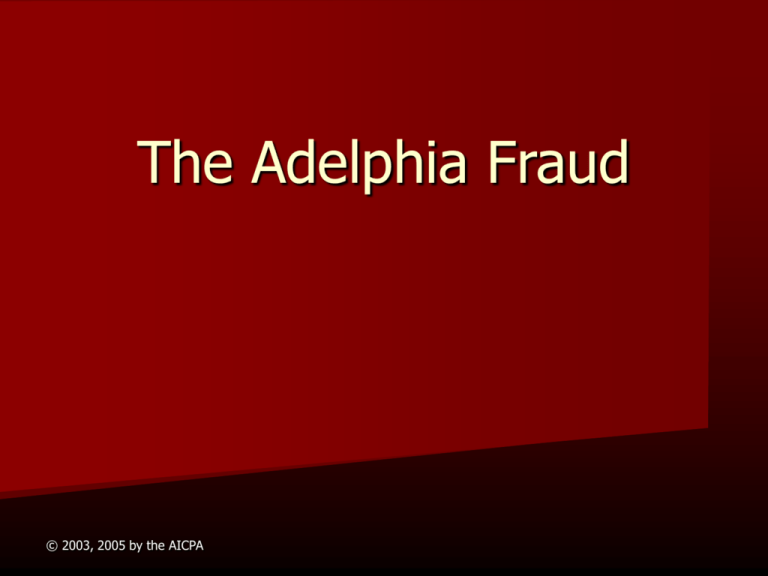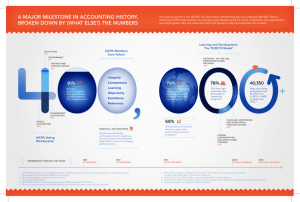
The Adelphia Fraud
© 2003, 2005 by the AICPA
This presentation is intended for use in higher education for instructional purposes only, and is not for application in
practice. Permission is granted to classroom instructors to photocopy this document for classroom teaching purposes
only. All other rights are reserved. Copyright © 2003, 2005 by the American Institute of Certified Public Accountants,
Inc., New York, New York.
Adelphia’s Background
John Rigas purchased cable company in
1952 for $300 in Coudersport, Pennsylvania
He purchased it to hedge against lost sales
for his movie theater
In 1972, he and his brother, Gus, created
Adelphia Communications Corporation
© 2003, 2005 by the AICPA
Adelphia’s Background
Adelphia is Greek for “Brothers”
– Signifies the Greek heritage
– Corporation run by brothers
Adelphia has always been a “family” business
In the late 1990s, it purchased Century
Communications for $5.2 billion and became the 6th
largest cable company with 5.6 million subscribers
© 2003, 2005 by the AICPA
John Rigas (Adelphia Founder)
Loves Limelight/Service
– Board of Directors
National Cable Television
Citizens Trust Company
Charles Cole Memorial Hospital
– President of several committees
© 2003, 2005 by the AICPA
John Rigas (Adelphia Founder)
Ordered network to show him “at least once”
during Sabres’ games
Bought homes for people
Flew people on private planes for medical
treatment
Gave huge amounts to charities
Had to approve every business transaction
© 2003, 2005 by the AICPA
John Rigas (Adelphia Founder)
Characteristics of a fraud perpetrator
–
–
–
–
Egocentrism
Omniscience
Omnipotence
Invulnerability
© 2003, 2005 by the AICPA
The Family Business
Family Members in Management include:
– John Rigas, Founder and Chairman (Father)
– Tim Rigas, CFO and Board member (Son)
– Michael Rigas, EVP and Board member (Son)
– James Rigas, EVP and Board member (Son)
– Peter Venetis, Board member (Son-in-law)
Family Management =
Majority of Adelphia’s
Voting Stock
© 2003, 2005 by the AICPA
Majority on Adelphia’s
Board of Directors
Extravagant Lifestyle symptoms
Several Vacation Homes and luxury
apartments in Manhattan
Several private jets
Construction of a world-class 18-hole golf
course
Majority ownership of the Buffalo Sabres
$700,000 membership in an exclusive golf
club
© 2003, 2005 by the AICPA
The Fraud Charges
Violation of RICO act
Breach of fiduciary duties
Waste of corporate assets
Abuse of control
Breach of contract
Unjust enrichment
Fraudulent conveyance
Conversion of corporate assets
© 2003, 2005 by the AICPA
How the Fraud took place
Adelphia backed $2.3 billion worth of personal
loans to the Rigases
Rigas Management manipulated the books to
meet analysts’ expectations and inflate the stock
price
Rigases created private partnerships w/Adelphia
as a tool for the self-dealing schemes.
– Fund transfers were made through journal entries
that gave Adelphia more debt and the Rigases multimillion dollar assets at no cost.
© 2003, 2005 by the AICPA
How the Fraud took place (cont’d)
Rigas Management commingled Adelphia funds with
family funds causing Adelphia to fund non-corporate
projects, such as:
– Personal loans
– Real estate transactions
Purchase of Manhattan apartments for private use
Purchase of land for a private golf course
– Cash advances to the Buffalo Sabres
– $252 million to pay margin calls, or demands for cash payments
on loans for which the family had put up Adelphia stock as
collateral.
© 2003, 2005 by the AICPA
How the Fraud took place (cont’d)
Revenues from Adelphia subsidiaries and other
businesses were dumped into one central
account. They used this account to pay bills.
Financial affairs of Rigas Family Entities were
intermingled with Adelphia, but not
consolidated. (Off-the-balance sheet debt)
The Rigases used Adelphia’s line of credit for
personal purchases.
© 2003, 2005 by the AICPA
How the Fraud took place (cont’d)
Buffalo Sabres
Hockey
Family-owned
Farm
Interior Design
Shop
Rigas’ Family Entities
© 2003, 2005 by the AICPA
Money to the Rigases
Leased Vehicles to
Adelphia
Money to the Rigases
Furniture/Design
Services to Adelphia
Money to the Rigases
Landscaping, Maintenance to
Adelphia
Money to the Rigases
Tickets to Adelphia
Transaction Account from Adelphia Communications
Private Car
Dealership
How the Fraud took place (cont’d)
The Rigases doctored financial records at
Adelphia and created sham transactions
and phony companies to inflate the firm's
earnings and to conceal its mounting
debts.
Upon realizing the extent of funds taken,
Tim Rigas “limited” the amount of
Adelphia’s funds his father could take to
$1,000,000/Month
© 2003, 2005 by the AICPA
How the Fraud Evolved
It is commonplace for owners of family
businesses to think of the company’s
money as their own.
Adelphia’s management and board was
controlled by the Rigas family
The suit against the Rigas family details
the ways in which the family used
Adelphia in a rampant self-dealing scheme
© 2003, 2005 by the AICPA
The Aftermath
The company’s stock price plummeted after it was delisted
from the NASDAQ for failure to file its 2001 10-K. Shortly
after that, on June 25, 2002, it filed for bankruptcy.
© 2003, 2005 by the AICPA
Litigation
John and Timothy Rigas found guilty of
conspiracy, bank fraud and securities fraud
– await sentencing of possible 30 years in
prison.
Michael Rigas acquitted of conspiracy and
wire fraud. Awaiting a new trial on
securities fraud
Rigas family facing suit by Adelphia
© 2003, 2005 by the AICPA
Litigation (cont’d)
James R. Brown, VP of Finance pleaded guilty in
SEC case against him
Michael C. Mulcahey, VP and Assistant Treasurer
acquitted of criminal charges
Adelphia sues auditor Deloitte & Touche for
professional negligence, breach of contract,
fraud and other wrongful conduct.
Adelphia’s reorganization plan in emerging from
bankruptcy gives the Rigases nothing for their
holdings
© 2003, 2005 by the AICPA








